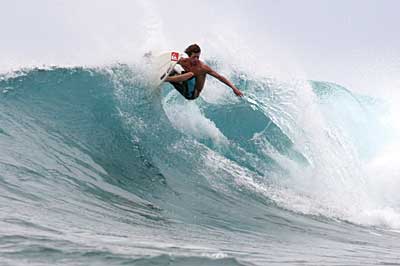The web’s top surfing destination, Surfline/Wavetrak, Inc., is an excellent study in resource management. It creates few videos in- house, but it uses its network of live cameras and its motivated army of contributors to great effect.
Not bad for a site that was born preweb. Surfline originally started as a dial-in service.
 “Surfline just celebrated its twenty-fifth anniversary,” explains Brian J. Mezger, the site’s vice president of technology. “It started out as a call-in service. It was a paid service: you’d call in and you’d get a recording and it would give you the conditions of the day and a short forecast.
“Surfline just celebrated its twenty-fifth anniversary,” explains Brian J. Mezger, the site’s vice president of technology. “It started out as a call-in service. It was a paid service: you’d call in and you’d get a recording and it would give you the conditions of the day and a short forecast.
“Then it moved into the fax world, where you could get faxes of the conditions and a forecast. In the late-90s, when the Internet started to expand and become mainstream, that’s when website came out. It’s gone through an infinite number of evolutions to where we stand today. We serve over a million-and-a-half unique visitors a month, and the site keeps growing and growing.”
The streams themselves have changed over the years. The company first streamed MOV files, went to Windows Media and then Flash, and now serves MP4/H.264 video. It doesn’t offer adaptive streaming, but it offers three static bitrates, with the highest a 720p HD feed. The company uses BitGravity, Inc. and Highwinds Network Group, Inc. as OVPs, with one reserved as a backup, able to handle demand if needed.
It’s Mezger’s job to manage software development, the site, and the network architecture.
There are two types of video on Surfline: surf condition videos and live and on-demand news and entertainment videos. The surf condition videos have proven to be a huge resource for the site. It uses 100 high-definition video cameras and 50 standard-definition cams mounted in Hawaii, the West Coast, and the East Coast. Some of the cameras are in a fixed position, while others offer pan/tilt/zoom controls.
Subscribers pay the site $9.95 per month or $69.96 per year for access to the cams, which they can reach on the web or a smartphone. The subscription also includes an extended 14-day forecast.
Because it’s such a valuable resource, The Weather Channel and local TV stations often make use of the streams free of charge, which provides valuable publicity for the site.
 “One of our most popular features, definitely, is the live cameras,” says Mezger. Surfline now has more than 40,000 subscribers, a figure he says is growing daily. The cams are also used in a related site called BuoyWeather, which is aimed at mariners.
“One of our most popular features, definitely, is the live cameras,” says Mezger. Surfline now has more than 40,000 subscribers, a figure he says is growing daily. The cams are also used in a related site called BuoyWeather, which is aimed at mariners.
One thing Mezger won’t say is what kind of cameras the site uses. His team has spent a lot of time on research and development, he notes, fine-tuning cameras, software, and network architecture to provide 99% uptime. That has to stay a competitive secret.
Surfing on Demand
While Mezger manages the surf condition cams, it’s Marc Beaty, the site’s video manager, who oversees Surfline’s news and entertainment videos. Not bad, considering he’s basically the entire in- house team. While he has a few other people on staff who help out, he’s largely a team of one.
“What we try to do is cover anything that’s happening in the professional surf world,” says Beaty. That’s a pretty big goal, and the way he gets it done is a lesson in creative resource management.
First off, Beaty produces five different original web series each month: 60 Seconds, which shows a great ride; Punt of the Month, which highlights an impressive air maneuver; Greatest Wipeouts, Beaty’s personal favorite; Primetime, which shows great moments throughout the world; and Super Sessions, which focuses on the world’s best surfers. Beaty tries to create one new episode of each show per month. The videos are high on action and offer no narration.
“Mostly it’s all about the action. All surfers want to see good surfing, whether it be giant waves or guys really pushing themselves or just high-performance, high-action, and high- profile surfing,” Beaty says. Growing up pre-internet, he used to enjoy high-action surfing video on VHS tapes.